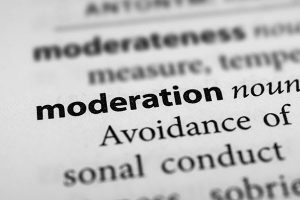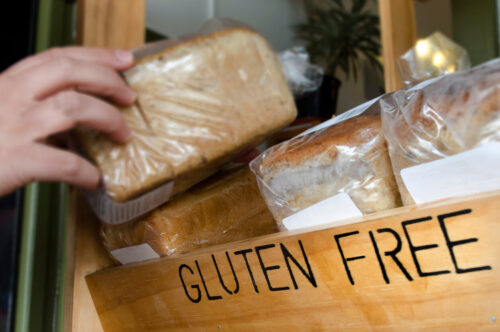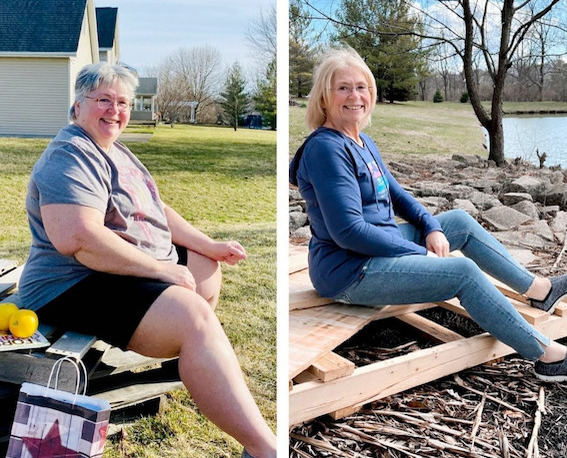Resisting the Broken Bone Businesses: Bone Mineral Density Tests and the Drugs That Follow
This article originally appeared in the October 2004 McDougall Newsletter.
By John McDougall, MD
Glenda writes: “Now, at age 45 and undergoing a rather early natural menopause, I had a ‘dexa bone scan’ to check my bone mineral density (BMD), which yielded the diagnosis of osteopenia, the precursor to osteoporosis. That very day I went to the ob/gyn doctor to discuss my “treatment options,” which I have been told are medications.”
Glenda is yet another victim of the “Broken Bone Businesses” – a conglomerate of pharmaceutical companies, medical instrument manufacturers, “consumer organizations,” and misinformed, but well-meaning, doctors who spread fear by targeting women’s worries about aging – threatening them with disability and premature death from broken bones due to osteoporosis. There’s a lot of money to be made from telling healthy people they are sick, and this activity is sometimes referred to as “disease-mongering.”1
Osteoporosis is a real health problem, affecting many more women than men. However, the emphasis needs to be placed on prevention with diet and exercise, rather than on expensive and relatively ineffective tests and drug treatments. Money is the obvious reason for the misplaced emphasis.
They Say Most Women Have Bad Bones
The first step in “disease mongering” is to define a disease in a manner that will lead to huge profits by selling the potential customer expensive tests and treatments. With osteoporosis this is done by establishing the diagnosis of this disease by measuring the density of the bones – bone mineral density (BMD).
According to the BMD standards used today, about two-thirds of middle-aged and older women in Western countries have bone disease worthy of testing and treatment. For example, using the population of British Columbia in 1995, estimates are 536,000 of the 813,560 women over age 40 (that is 66%) would be labeled as either having “osteoporosis” or a pre-osteoporosis condition, “osteopenia.”2 Another recent study found low BMD in 44% of participants younger than 65 years, and in 70% older than 65.3 The World Health Organization has estimated that 30% of all women over 50 (postmenopausal women) have osteoporosis.4 Stated in meaningful financial figures, the majority of women middle-aged and beyond are sick and in need of help from the “Broken Bone Businesses.”
The consequences of all this disease-mongering go beyond dollars. Just the thought of taking a BMD test creates fear and anxiety in a woman. The diagnosis of “thin bones” changes a woman forever from “healthy” to “sick.” If testing was universally accepted, then most women after menopause would be encouraged to take drugs, like estrogen/progestin (HRT) or bisphosphonates, like Fosamax (alendronate) and Actonel. These medications are for a lifetime and they have real side effects and financial costs. Undoubtedly, the BMD examination has the potential to do much more harm than good.
Drug Companies Create the Market
The diagnostic criteria of BMD used by drug companies, and almost all doctors, were set up by the World Health Organization (WHO). The WHO established the bone density (BMD) of young white women as “normal,” and as the standard by which to judge the bones of older women. Your suspicions should be raised by knowing a key meeting for the WHO group defining the diagnosis of osteoporosis was funded by three pharmaceutical companies.1
The second step in “disease mongering” is to aggressively search for older women with bones less dense than those of young women. In order to increase the number of “sick women” in need of medications, pharmaceutical companies encourage women to have their BMD measured by promoting testing through medical doctors, and by conveniently providing free or low-cost testing at shopping centers, workplaces, and health fairs. Realize, because of changes in a woman’s physical activity, her levels of female hormones and her reproductive role, her bones naturally become less dense as she becomes older. This change in her BMD does not mean she is now “diseased,” but rather that the demands on her skeletal tissues have changed with normal aging.
The truth is that for most people the risk of a fracture is low and/or distant (limited mostly to the very elderly) and the benefit from any drug is small. Furthermore, while bone density is associated with fracture risk, this test is not accurate enough to guide doctors to proper treatments. A recent analysis of 11 separate study populations and over 2000 fractures found that bone mineral density “cannot identify individuals who will have a fracture.”5 The authors concluded, “We do not recommend a program of screening menopausal women for osteoporosis by measuring bone density.5 In other words, BMD testing does not accurately identify women who will go on to suffer a fracture as they age, and is, therefore, unable to accurately distinguish women at low risk of fracture from those at high risk.
There are characteristics which will predict a woman’s risk for future fractures more accurately than BMD, such as her age, having a close relative with a history of a serious fracture, her activity level and her overall quality of health. The reason for this is because fractures are due to poor overall bone quality, and not directly the result of a lesser amount of calcium found in her bones by testing.
The Reason BMD Is Inaccurate6
Bones are made of living tissues. Minerals, like calcium, are deposited within these tissues. Osteoporosis is caused by the disintegration of this vital structural material, which is made up of proteins, fats, minerals, and many other biologically active substances. When the bone tissues disintegrate, calcium is also lost. The loss of calcium seen on the BMD is misinterpreted to mean osteoporosis is caused by calcium loss – this is not true. Calcium is only one element necessary for the proper development of bone, and its presence alone cannot compensate for degenerating tissues.
Confirming this poor association of calcium (BMD) and bone strength is the observation that “bone building drugs,” such as HRT and Fosamax, show a decrease in risk of fracture with very little improvement in BMD.6 One classic example of how “nice-looking bones,” with high BMD, can actually be very weak bones, is seen with fluoride treatment of osteoporosis. This mineral supplement noticeably increases bone density, yet at the same time bone fragility and fractures are dramatically increased because the bone tissues are sickened by the treatment.7 Surprising for many people is the fact that taking calcium supplements can actually suppress the growth of bone tissue (by suppressing parathyroid hormone activity) and increase the risk of fractures.6
What Is Your Actual Risk and Benefit?
Women are sold “anti-osteoporosis therapies,” such as hormone replacement therapy (HRT) and Fosamax and Actonel, with promises such as, “You will double your risk of fractures if you do not take this medication.” But what does that mean to you in real numbers?
The public promotion of the benefits of treatments relies upon the use of “relative risk reduction,” instead of the “absolute risk reduction.” For example, Fosamax taken for four years by women who are free of fractures, but who have a bone mineral density that would indicate they have trouble and need treatment, found fractures of the spine to occur in 3.8% in the placebo group and 2.1% in the drug group.8
So, the absolute reduction was only 1.7% – a figure that in real-life terms, appears insignificant, and hardly deserving of a costly lifelong medication with serious side effects. However, when presented in the deceitful terms of relative risk reduction, the benefits from treatment sound too good to refuse. The relative risk reduction is 44%.
The relative risk reduction is obtained by dividing the absolute figures – 2.1% by 3.8%, which equals 56%, – and then subtracting this number from 100%, which equals 44%. In other words, you cut your risk almost in half by taking drugs, but your original risk was very low, so in real numbers you gain exceedingly little.
What Organizations Say about BMD
Pharmaceutical industries provide funding for sham “consumer organizations,” such as the International Osteoporosis Foundation, to promote their agenda. Here is what this industry front says about BMD:
“Bone mineral density (BMD) measurements are effective in assessing fracture risk, confirming a diagnosis of osteoporosis and monitoring the effect of treatment.”
Other phony industry-sponsored “consumer organizations” with similar support for BMD and treatments are the US National Osteoporosis Foundation and the Osteoporosis Society of Canada.
Now consider these assessments of the value of BMD made by organizations not supported by industries:2
Office of Health Technology Assessment, University of British Columbia:
“Research evidence does not support either whole population or selective bone mineral density testing of well women at or near menopause as a means to predict future fractures.”
The International Network of Agencies for Health Technology Assessment:
“The currently available evidence does not support the use of BMD screening in combination with hormone replacement therapy or intranasal salmon calcitonin treatment.”
Canadian Task Force on the Periodic Health Examination:
“Widespread bone mineral density screening is inadvisable at present.”
U.S. Preventive Services Task Force:
“There is insufficient evidence to recommend for or against routine screening for osteoporosis with bone densitometry in postmenopausal women.”
Swedish Council on Technology Assessment in Health Care:
“There is no scientific basis for recommending bone density measurement in mass screening, selective screening, or as an extra component in health check-ups of asymptomatic individuals (opportunistic screening).”
University of Newcastle Osteoporosis Study Group, Australia:
“In summary, the measurement of BMD is not a useful screening test for the identification of women at high risk of hip fracture and requiring preventative treatment with estrogens.”
Effective Health Care Bulletin, U.K:
“Given the current evidence, it would be inadvisable to establish a routine population based bone screening programme for menopausal women with the aim of preventing fractures.”
Osteoporosis Is Real, Preventable, and Curable
For most women, I recommend they do not have BMD testing done in the first place. If, however, they have already gone that route, and are now facing an abnormal BMD test result, then I recommend they delay accepting drug treatment (unless they have evidence of severe osteoporosis complicated by fractures). In most cases, a repeat BMD test two to three years later is the only future test I recommend. In the meantime, a woman should be eating a healthy diet and exercising. Her efforts are expected to cause her next BMD test results to be the same (showing no further loss) or improved (showing some gain) over the first test that initiated the doctor’s recommendation for drugs.
A few women concerned about their bones may also choose HRT (I usually recommend estradiol 0.05 mg with 20 mg of progesterone to be used daily as a skin cream). HRT is very effective for strengthening bones, along with benefits for alleviating hot flashes and vaginal dryness. However, there are very small, but concerning, risks of breast and uterine cancer, blood clots, and gallbladder disease to consider in this decision. (Read the McDougall Program for Women book for much more information on these subjects.)
The assaults on bone health caused by the American diet are well-established. The most serious damage comes from the high acid content of cheese, red meat, poultry, fish, seafood and eggs – the centerpieces of most people’s diets. After this acid enters the body it must be neutralized. The primary buffering (acid-neutralizing) system of the body is the bones, which dissolve to release alkaline substances. The next stage of loss occurs with the kidneys where the bone material is filtered into the toilet. Consuming alkaline foods (fruits and vegetables) is the most important step you can take to preserve your bones and actually reverse bone loss. (Note: legumes and grains are slightly acidic and should be limited by people at great risk for bone loss.) Exercise is an established way to rebuild lost bone and prevent future fractures.
A woman is designed to live, on average, 85 years in good health. Logically, her bone tissues should be strong and fracture-resistant for all those years, too. In order to realize this life plan, a woman must resist billions of corporate dollars teaching false messages. Instead, as against other common diseases, she must defend herself and avoid the medical businesses by staying healthy by taking advantage of the simple cost-free effects of a proper diet and lifestyle.
References:
1) Moynihan R, Heath I, Henry D. Selling sickness: the pharmaceutical industry and disease mongering. BMJ 2002; 324: 886-891
2) British Columbia Office of Health Technology: Building Bridges Conference. April 2000: http://www.chspr.ubc.ca/bcohta/pdf/bco00-05C.pdf.
3) Rohr CI, Sarkar A, Barber KR, Clements JM. Prevalence of prevention and treatment modalities used in populations at risk of osteoporosis. J Am Osteopath Assoc. 2004 Jul;104(7):281-7.
4) WHO Study Group on Assessment of Fracture Risk and its Application to Screening for Post Menopausal Osteoporosis. Assessment of fracture risk and its application it screening for post menopausal osteoporosis: report of a WHO study group. Geneva: WHO, 1994. (WHO technical series 843.)
5) Marshall D, Johnell O, Wedel H. Meta-analysis of how well measures of bone mineral density predict occurrence of osteoporotic fractures. BMJ 1996;312:1254-1259.
6) Wilkin TJ. Changing perceptions in osteoporosis. BMJ. 1999 Mar 27;318(7187):862-4.
7) Fratzl P, Roschger P, Eschberger J, Abendroth B, Klaushofer K. Abnormal bone mineralization after fluoride treatment in osteoporosis: a small-angle x-ray-scattering study. J Bone Miner Res. 1994 Oct;9(10):1541-9.
8) Cummings SR, Black DM, Thompson DE, Applegate WB, Barrett-Connor E, Musliner TA, Palermo L, Prineas R, Rubin SM, Scott JC, Vogt T, Wallace R, Yates AJ, LaCroix AZ. Effect of alendronate on risk of fracture in women with low bone density but without vertebral fractures: results from the Fracture Intervention Trial.
JAMA. 1998 Dec 23-30;280(24):2077-82.
9) Banks E, Beral V, Reeves G, Balkwill A, Barnes I; Million Women Study Collaborators. Fracture incidence in relation to the pattern of use of hormone therapy in postmenopausal women. JAMA. 2004 May 12;291(18):2212-20.
Recommended Articles

The Myth of Moderation: Do All Foods Really Fit?

Gluten-Free Diets Are Harmful for the General Population (Except for One Percent)






